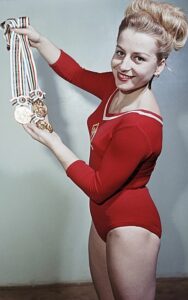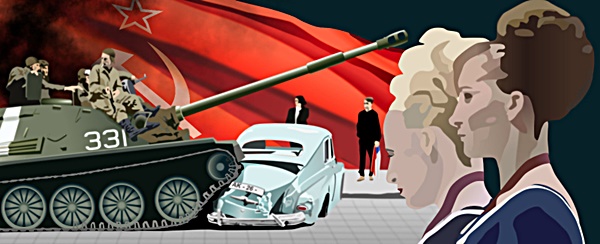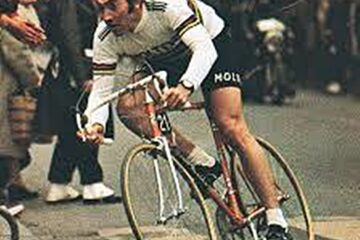Vera Čáslavská (1942 – 2016): The Czech Gymnastics Icon Who Defied Gravity and Tyranny!

Vera Čáslavská (1942-2016)
The Greatest Gymnast!
In the realm of gymnastics, few names shine brighter than Vera Čáslavská.
Born on May 3, 1942, in Prague, Czechoslovakia, this trailblazing athlete left an indelible mark on the sport, her country, and the world.
Rise to Prominence Čáslavská’s journey began at age 7, under the watchful eye of coach Jaroslav Míšek. Her natural talent, discipline, and dedication propelled her to the national team by 15. As she soared through competitions, Vera’s artistry, precision, and innovative routines redefined the boundaries of gymnastics.

Golden Moments
The 1960 Rome Olympics marked Čáslavská’s international breakthrough, securing her first gold medal in the balance beam. However, it was the 1964 Tokyo Olympics where she truly cemented her status as a gymnastics legend, claiming three gold medals and one silver.
The 1968 Mexico City Olympics would prove to be Čáslavská’s most iconic moment. She won four gold medals and two silver, becoming the first gymnast to capture individual gold in every event. This remarkable achievement solidified her position as one of the greatest gymnasts of all time.
In April 1968 Caslavska had signed the “Manifesto of 2000 words” which rejected soviet involvement in Czechoslovakia. On August 21, she was at the training camp in Moravia when soviet tanks rolled into Prague. Warned by friends that she was in danger of arrest, Caslavska fled to the small town of Sumperk in the Jeseniky Mountains. With the Olympics only two months away, Caslavska was in hiding, keeping in shape by swinging from tree limbs and practicing her floor exercise in a meadow.
After three weeks, the government consented to let her join the rest of Czechoslovak team in Mexico.
After one of Caslavska performances on the balance beam received a 9.6, the audience spent ten minutes booing, howling and chanting “Ver-a, Ver-a” until finally her mark was upped to 9.8. The last performer in the final event, Caslavska thrilled her admirers by performing her floor exercise to the tune of “The Mexican Hat Dance”.

She eventually earned four gold medals and two silver to add to a three gold and two silver she had won four years earlier in Tokyo. In the floor exercise she shared first place with Larisa Petrik of the Soviet Union, which meant the two women stood together on the top platform at the medal ceremony and listened first to Czechoslovakia national anthem and then to the U.S.S.R`s.


Political observers noted that Caslavska bowed her head and turned away during the playing of Soviet anthem.
Twenty-four hours later Caslavska topped off her week by marrying Czechoslovak 1500m champion Josef Odlozil. After a civil ceremony at the Czechoslovakian ambassador`s house, the happy couple pushed their way through a mob 10.000 people to get to the altar to the Roman Catholic Church in Xocalo Square. The couple divorced in 1992. The following year, their teenage son, Martin, killed Odlozil during a fight at a pub.
Vera Caslavska personal odyssey in the years after her Olympic triumph mirrored the political fortunes of her nation. Heroine of Mexico City, she may have been, but the Communist authorities did not forget her public support of the “Manifesto 2000 Words”.
They made absolutely sure that she would remain unemployed unless she repudiated the Manifesto.
She refused. Every year on January 3, Caslavska appeared at the office of Antonin Himmel, the Czechoslovak sports minister, and asked for a coaching job with national team. Every year he turned her down. Realizing that creative tactics were needed, she showed up for her 1975 appointment with a surprise under her coat.
Fifteen years later she told “The New York Times” that she wore “an aerobics suit, high in the neck, very tight”. When interviewed by France`s “L`Equipe Magazine”, Caslavska described her outfit as “an extremely low-cut-T-shirt.
Whatever the details, she explained to Himmel and twenty of his associates that she was dressed for work and would not leave until she was given a team to coach. Caslavska was assigned to a local club on the condition that she not leave the country . Visiting journalists who asked for her were told that she was not available.
Then, in 1979, the president of Mexico, Jose L. Opez Portillo, asked if Caslavska could come to Mexico and coach the national team. The Czechoslovakian government was desperate for access to Mexican oil and so Caslavska was allowed to leave the country for the first time in eleven years.
However, when she returned to Prague in 1981, she was again forbidden from meeting foreign visitors.
Finally in 1985, the wall around Caslavska began to crack when I.O.C president Juan Antoni Samaranch insisted on presenting an award to Caslavska and fellow Olympic champion and “2000 Words” signer Emil Zatopek.
Upon the collapse of the communist regime in November 1989, Caslavska`s situation changed dramatically. Her 21 years-old defiance of the hated communism government was suddenly an asset, as was her friendship with author Vaclav Havel, who was selected president of the new government.
Caslavska was appointed president of Czech National Olympic Committee and later became a member of the International Olympic Committee. Of course, the world of gymnastics, like the world at large is not made up only of happy endings.

Episode 1
Overcoming Injury
Leading up to the 1968 Olympics, Čáslavská faced a significant setback. She suffered a serious ankle injury, forcing her to reconsider her participation. Undeterred, Vera underwent intensive rehabilitation and modified her training regime. Her determination paid off, as she not only competed but dominated the Olympics.
A Silent Protest Amidst the jubilation of her 1968 Olympic victories, Čáslavská subtly yet courageously expressed her dissent against the Soviet invasion of Czechoslovakia. As she received her medals, she looked down or away, her quiet defiance echoing loudly across the globe.
Episode 2
Defying Soviet Pressure
In 1968, Čáslavská was pressured by Soviet officials to sign a statement condemning the Czechoslovakian reform movement. She refused, risking her career and personal safety. This brave stance earned her international admiration and cemented her status as a symbol of resistance.
Life Beyond Gymnastics Following her retirement, Čáslavská continued to inspire generations as a coach and judge.
Her legacy extends far beyond her impressive medal count:
– Innovative techniques and routines that transformed the sport
– Advocacy for women’s sports and equality
– A symbol of resistance against oppression International Recognition
In 1998, Čáslavská was inducted into the International Gymnastics Hall of Fame, a testament to her enduring impact. Her remarkable story has inspired countless gymnasts, including Nadia Comăneci and Simone Biles.
Episode 3
Reconciliation and Legacy
In 1990, after the fall of communism, Čáslavská returned to Czechoslovakia to help rebuild the country’s gymnastics program. She worked tirelessly to promote the sport, inspiring a new generation of gymnasts. Her legacy continues to inspire athletes and individuals worldwide to stand tall against adversity.
Vera Čáslavská’s life serves as a powerful reminder of the intersection of sports and politics, courage and conviction.
Though she passed away on August 30, 2016, her spirit continues to soar, inspiring athletes and individuals worldwide.
By Pjerin Bj
New York: November 15, 2024
__________________
Sports Vision +Plus / Champions Hour in activity since 2013
References: “The Complete Book of The Summer Olympic Games” (The Overlook Press, Woodstock & New York) – David Wallechinsky (Sydney 2000 Edition) p. 539
Discover more from Sports Vision +
Subscribe to get the latest posts sent to your email.












